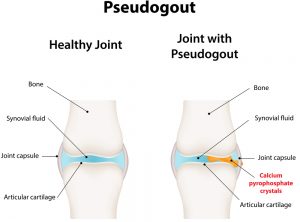Significance, Symptoms, Cause and Treatment of pseudogout (or: Chondrocalcinosis)
Pseudogout is a form of rheumatism that often occurs around the 65th year of life. The official name of this condition is chondrocalcinosis. This is a contraction of the Latin words ‘chondro’, which means ‘cartilage’ and ‘calcinose’, which can best be translated as ‘calcium deposition’. This also indicates the large difference between pseudogout and gout. In pseudogout, the crystals deposited in the joints do not consist of uric acid but of lime. However, the complaints of both forms of ‘crystal rheumatism’ are almost equal, which are painful and swollen joints.
What is the cause of pseudogout?
In the case of pseudogout, calcium crystal deposits occur in the cartilage. The joint fluid then absorbs these calcium crystals. The body’s immune system then starts to remove this unwanted pollution of the joints, which causes inflammation. Unfortunately there is no conclusive evidence as to why some people experience calcium crystal deposits in the joints. Sometimes this may be due to an excessive calcium level in the blood or excess iron in the tissues. Also, low levels of magnesium in the blood can play a role in the development of chondrocalcinosis. However, most people with pseudogout do not suffer from these issues. Complaints usually occur after a trauma, such as an infection, surgery or accident. Pseudogout can also occur at a young age in people with a hereditary or metabolic disorder.
What are the symptoms of pseudogout?
In acute chondrocalcinosis, pain results from severe inflammatory reactions. This is the result of the cleanup action that the body suddenly starts to remove the accumulated calcium crystals in and around the joints. It usually affects the relatively larger joints of the body, such as knees, wrists, ankles and shoulders. These joints hurt, become swollen and feel warm. As a result, joints have less mobility. Within 12 to 36 hours the attack has reached its peak. The symptoms can last for days to weeks.
In chronic chondrocalcinosis, inflammation occurs very gradually. The attacks come back more often, last longer and extend to other joints of your body. This can lead to chronic inflammation. As with acute pseudogout, the large joints can swell and feel painful and stiff. But the inflammations can also extend to the smaller joints of the body. In the acute and chronic form, inflammation can cause high fever.
How do you diagnose pseudogout?
Diagnosing pseudogout is quite simple. Of course, the doctor will first ask for your symptoms. Then a physical examination is preformed. Your doctor may remove fluid from the inflamed joint, using a needle. This fluid is examined under the microscope for the presence of calcium crystals. In addition, your doctor may also take X-rays. The calcium deposition on the joints is clearly visible. Moreover, your doctor may also preform a blood test to see if there is any other rheumatic or metabolic disease present.
How do you treat pseudogout?
Unfortunately, there are no medications that can prevent calcium crystals from depositing on the joints. This means that this condition cannot be cured. The goal of any treatment is to fight the inflammation, and to prevent joint damage. Usually, your doctor will prescribe an NSAID. These anti-inflammatory pain killers usually work fast. Unfortunately, the use of this type of medication may be associated with gastrointestinal problems.
Alternatively, one may try the liquid Green-lipped mussel with Bio-Curcumin and Blackcurrant leaf. This is a natural anti-inflammatory supplement with no annoying side effects. Your doctor may also decide to inject the inflamed joint with a corticosteroid or prescribe colchicine. This is a medication that helps prevent inflammatory attacks. The disadvantage of injecting corticosteroids into a joint is that it causes damage to the cartilage. Furthermore, it is important to rest your body during an attack. Then you can move again. Referral to a physical therapist may also be helpful.

Share this page
Tweet

Download for free the booklet ‘Moving without pain’ with a retail value of $6.75 / £4.95.
Any questions? Please feel free to contact us. Contact us.






